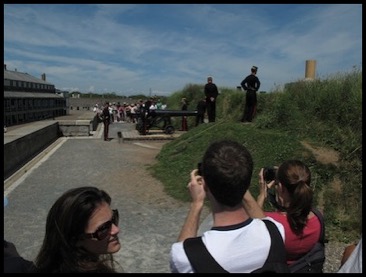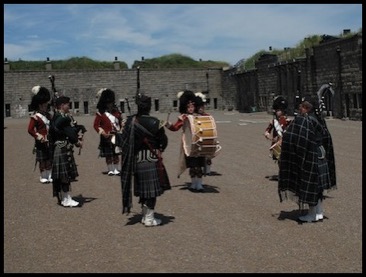Halifax Harbour
04/07/12 13:30 Filed in: Travel
Today was our day to visit Halifax since we will hit the road early to see a Ceilidh in Judique on Cape Breton Island. We love celtic music and this area is certainly a center of it. Many good artists come from this region.
But I jump ahead. This morning we toured The Citadel. This is the main fortress on top of a hill overlooking Halifax harbour. It is now a tourist site yet was an active fortification for 200 years. There were many young men in dress uniform performing tasks. In questioning, we find that they are students primarily working and performing a role and not active military. They seem to do a good job and certainly appear authentic. The following is a picture of the Clock Tower at the base of the Citadel with the Convention Center just behind along with Halifax Harbour even farther in the distance. The Clock Tower is very distinctive landmark in the city.

The Citadel was established in 1746 and the Noon Gun has been fired every day since 1856, maybe even since the 1700’s. We were fortunate to watch the military ceremony to load and fire the Noon Gun. You can see from this picture below how they were set up to fire.

The Pipes and Drum corps were on hand at shortly after noon to play a rousing group of songs. I can see why at one time they banned the bagpipes as a war weapon since it can be rousing to follow the call of the pipes and drums. A great way to get in the mood for our celtic journey.

The rest of the afternoon was spent touring the Maritime Museum of the Atlantic. It had a lot of interesting exhibits under its roof. Two that caught my interest were one-- the display on the ships and people who laid communication cable from Nova Scotia or Newfoundland across the Atlantic to Britain or France over the last 100 years plus. Dangerous work with a need for many skills. One cable ship responded to the Titanic disaster since they were better able to retrieve the bodies that were found from the ocean surface. The other exhibit covered the terrible disaster that hit Halifax on the morning of December 6, 1917. A French munitions ship, the Mont Blanc, was entering the harbor and was hit by a Norwegian vessel, the Imo. A fire started and burned on the Mont Blanc. The French sailors knew the danger and left the ship to take shelter in nearby woods. Many of the people in Richmond (this section of Halifax) were unsuspecting or went to sightsee. A massive explosion leveled the area killing thousands and injuring possibly 25,000. A personal note in a film shown at the museum said one family lost 25 members. So very sad.
But I jump ahead. This morning we toured The Citadel. This is the main fortress on top of a hill overlooking Halifax harbour. It is now a tourist site yet was an active fortification for 200 years. There were many young men in dress uniform performing tasks. In questioning, we find that they are students primarily working and performing a role and not active military. They seem to do a good job and certainly appear authentic. The following is a picture of the Clock Tower at the base of the Citadel with the Convention Center just behind along with Halifax Harbour even farther in the distance. The Clock Tower is very distinctive landmark in the city.

The Citadel was established in 1746 and the Noon Gun has been fired every day since 1856, maybe even since the 1700’s. We were fortunate to watch the military ceremony to load and fire the Noon Gun. You can see from this picture below how they were set up to fire.

The Pipes and Drum corps were on hand at shortly after noon to play a rousing group of songs. I can see why at one time they banned the bagpipes as a war weapon since it can be rousing to follow the call of the pipes and drums. A great way to get in the mood for our celtic journey.

The rest of the afternoon was spent touring the Maritime Museum of the Atlantic. It had a lot of interesting exhibits under its roof. Two that caught my interest were one-- the display on the ships and people who laid communication cable from Nova Scotia or Newfoundland across the Atlantic to Britain or France over the last 100 years plus. Dangerous work with a need for many skills. One cable ship responded to the Titanic disaster since they were better able to retrieve the bodies that were found from the ocean surface. The other exhibit covered the terrible disaster that hit Halifax on the morning of December 6, 1917. A French munitions ship, the Mont Blanc, was entering the harbor and was hit by a Norwegian vessel, the Imo. A fire started and burned on the Mont Blanc. The French sailors knew the danger and left the ship to take shelter in nearby woods. Many of the people in Richmond (this section of Halifax) were unsuspecting or went to sightsee. A massive explosion leveled the area killing thousands and injuring possibly 25,000. A personal note in a film shown at the museum said one family lost 25 members. So very sad.
blog comments powered by Disqus

